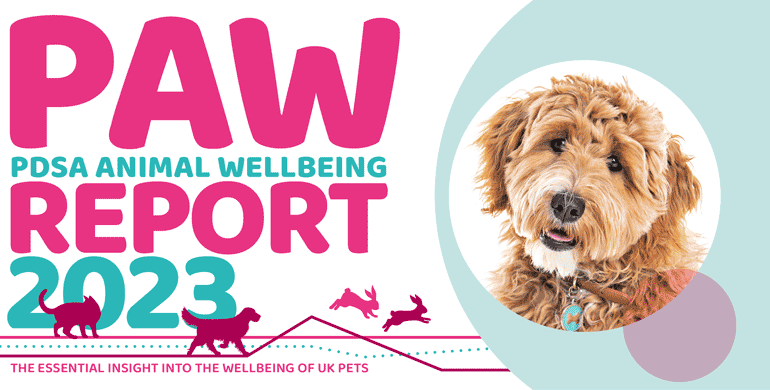Pet Populations
Since 2011, on an annual basis, the PAW Report has collected nationally representative data to accurately determine the proportion of people in the UK who own a pet and to estimate the total population of the UK’s pet dogs, cats, and rabbits. Consistent methodology, applied over the last 13 years, enables us to compare the data and provides a true picture of how UK pet populations are changing over time.
Our data show that the estimated population of pet dogs in the UK has increased to 11 million since February 2020 when it was 10.1 million. However, there has not been a statistically significant change in the estimated population size of the UK’s pet cats or rabbits over the same time period.
The number of pets in the UK in 2023


Click to see 10 years of data
Survey findings
In 2023, 53% of UK adults own a pet, (increased from 51% in February 2020) with 29% owning a dog, 24% a cat and 2% a rabbit. This is a higher proportion for dogs compared to February 2020, when 26% of UK adults owned a dog.
Although there have been some fluctuations across the 13 years of data, the estimated dog population has risen overall from 8.3 million in 2011 to 11 million in 2023. The consistent methodology of the PAW Report enables us to see that this has been an ongoing overarching gradual increase, and there has not been a dramatic jump in the dog population since 2020 in response to the COVID-19 pandemic. While the dog population in 2023 is higher than in February 2020, this appears to be in line with the ongoing gradual increase, albeit with some fluctuation along the way.
36% of all owners acquired their pet in the last three years, meaning that 8.3 million pets (4.1 million dogs, 3.7 million cats and 580,000 rabbits) have been acquired since the start of the COVID-19 pandemic in March 2020. This is higher for rabbit owners (53%) compared to dog owners (37%) and both are higher than cat owners (34%).
67% of veterinary professionals say they have seen an increase in the pet population in the last two years, with 71% of those saying they think this is because they are seeing more pets in their practice, and 54% because they are seeing more new pets in their community.
The financial commitment of owning a pet could mean that the rising cost of living has the potential to influence people’s decision to get a pet. However, our findings do not yet show an impact on pet acquisition – 13% of owners have acquired their pet in the last 12 months (13% of dog, 13% of cat, and 18% of rabbit owners). This is not significantly different to any other recent years (2017 to 2022), although it is higher than in February 2020 (11%).
23% of all pet owners told us they have not previously owned any pet as an adult (increased from 21% in both 2022 and 2021), and 38% of all pet owners told us this is their first experience of owning this species of pet as an adult, which we have defined as ‘new’ pet owners. More rabbit owners (51%) are ‘new’ owners than dog owners (41%), and both are higher than cat owners (34%). The proportion of all pet owners classed as ‘new’ (38%) has increased since 2021 (34%) and 2022 (36%), driven by a higher proportion of new dog owners in 2023 (41%) compared to 2021 (34%). In 2023, the demographics of these ‘new’ pet owners are very similar to our findings in 2022, i.e. more likely to be aged under 45, have a higher household income and be working full time.
The increase in the proportion of ‘new’ owners is an interesting trend, and we will continue to monitor it through future PAW Reports. While we may still be seeing the effects of lifestyle changes due to the pandemic, when spending more time at home meant people felt they had the opportunity to own a pet, there is some nationwide evidence of a return to pre-pandemic behaviours, with a decrease in home working and a return to the workplace, possibly driven in part by the rising cost of living1.
55% of dog owners told us that their dog was a pedigree and 28% that their dog was a crossbreed. These proportions have not changed since 2020, although the proportion of pedigree dogs is lower than in 2017 (61%).14% of dog owners told us their pet was a ‘specialist’ crossbreed (e.g. labradoodle), which has steadily increased over the last five years (8% in 2017, 9% in 2018, 10% in 2019, and 11% in Feb 2020).
86% of cat owners told us that their cat is a “moggie” (domestic shorthair or longhair), and 11% told us their cat is a pedigree. These proportions have fluctuated over the last few years and there are no clear trends in the data.
Key findings from the 2023 PAW Report
 Video found at youtu.be/Ml1C_552p6E
Video found at youtu.be/Ml1C_552p6E


